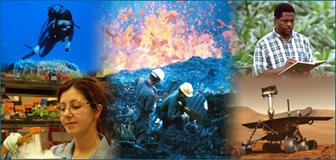Part 12 . Область моих научных интересов
What is Science?
In ancient times science (from the Latin word scientia) meant knowledge or learning. Today we define science as the study of the world around us. The study of science helps us to answer how, what, where, and why questions concerning our surroundings. But science is more than a collection of facts. Science is a human work. It is a growing and an exciting search for what is true. In this sense, science is a way of solving problems.
The word "science" probably brings to mind many different pictures: a fat textbook, white lab coats and microscopes, an astronomer peering through a telescope, a naturalist in the rainforest, Einstein's equations scribbled on a chalkboard, the launch of the space shuttle, bubbling beakers etc. All these images reflect some aspects of science, but none of them provides a full picture because science has so many facets:

Science is both a body of knowledge and a process. Studying at school, science may sometimes seem like a collection of isolated and static facts listed in a textbook, but that's only a small part of the story. Science is also a process of discovery that allows us to link isolated facts into coherent and comprehensive understanding of the natural world.
Science is exciting. Science is a way of discovering what's in the universe and how these things work today, how they worked in the past, and how they are likely to work in future. Scientists are motivated by the thrill of seeing or figuring out something that no one has had before.
Scientists accept that the observations and scientific results must be "objective." That is they must be repeatable, testable and confirmable by other scientists, even (and especially) skeptical ones. The edifice of law and theory that science builds must be representative of a "shared" perception that can be observed and verified by anyone equipped with good observation skills and appropriate measuring tools. Modern science uses language and concepts that go far beyond the directly and immediately observable, but there must always be logical links and experimental operational links between these concepts and things we can observe.
To craft scientific models and theories, scientists must brainstorm, innovate and speculate. That's the creative component of the activity. But they must also maintain a disciplined rigor to ensure that their theories and models fit into a logical and consistent interrelated structure. The final edifice called science allows deduction of predictions about the world, predictions that may be tested against observations and against precise measurements made on nature. Nature is unforgiving of mistakes, and when experiments disagree with the predictions of scientific laws and models these laws and models must be modified or scrapped.
Science has many branches such as physical science, earth science, and life science. Life science is the study of living things -plants and animals. It helps to explain how living things relate to one another and to their surroundings.
Put yourself in the place of a life scientist. Try to figure out the following press releases. Can you explain these events?
CHINE: DECEMBER, 1974 - Snakes crawled from their winter sleeping places. They froze to death in the winter cold. Rats also behaved in a strange way. They came out of their hiding places and wandered around the streets in broad daylight. These events were followed by an earthquake.
CHINA: FEBRUARY, 1975 - Geese were seen flying into trees. Dogs howled for no clear reason. These events were followed by an earthquake.
GREECE: 856 - Mice, weasels, and other burrowing animals were seen fleeing from the ancient city of Helice. Five days later the city was leveled by an earthquake.
Earthquakes affect all the living things. Because life scientists study the behavior of living things they are able to predict earthquakes. It is one of many ways life science is used in the world.
How science and technology influence you
Technology is the use of scientific discoveries. Transportation, communication, food, medicine, and most of what you see around you are the result of technology. Technology based on life science has resulted in many useful applications. Plants that don't get sick easily, shots that prevent mumps and measles, X rays that show cavities, and organ transplants are just a few applications. The world is a better place because of science.
Exercise 1. Master the active vocabulary.
to peer – вглядываться , всматриваться
rainforest – тропический лес
to scribble – писать каракулями , небрежно
shuttle – затвор шлюза
facet –аспект
to figure out – вычислять; понимать, постигать
edifice – ['edifis] здание, сооружение
perception – восприятие
to verify – проверять, подтверждать
brainstorm – буйный припадок, душевное потрясение
speculate – размышлять; делать предположения
predictions – предположения
to scrap – выбрасывать
earthquake – землетрясение
weasel – ласка
to burrow – рыть нору, прятаться в норе, жить в норе
mumps – свинка (болезнь)
measles – корь
Exercise 2. Answer the following questions:
1) What is science?
2) Science is both a body of knowledge and a process, isn’t it?
3) Why must scientific results be « objective»?
4) What branches does science have?
5) Do you think it is possible to live without science and technology?
6) How do science and technology influence the humanity?
Exercise 3. Find in the text the English equivalents to the following words and word combinations:
измерительные инструменты
наука о мире вокруг нас
быстро портиться
работа человека
повторяющиеся
подтверждаемые
логические связи
душевное потрясение
наблюдения
точные измерения
трансплантанты органов
